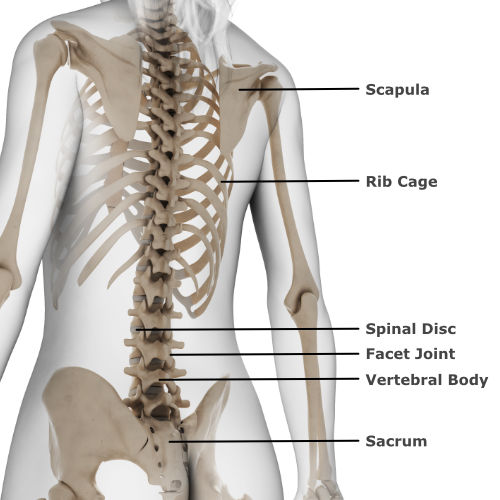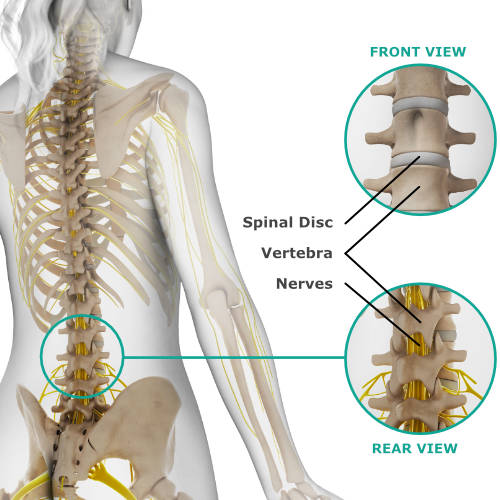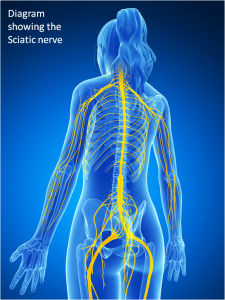500+ Google Reviews
★★★★★ 4.9/5
4.9 out of 5
The best physios by far...
Truly outstanding experience...
...very friendly and welcoming.
...tons of experience.
...they have been amazing.
Whilst extremely common, the exact cause of lower back pain can be difficult to diagnose. Our expert Physios have years of experience in treating back pain and can help get you back to fitness.
The spine is a strong and uniquely evolved structure which provides support and protection whilst at the same time allowing for adequate flexibility and movement. The anatomy of the spine is made up of a number important structures including the:
The discs in of the low back are strong structures made out of a tissue called collagen that has a ‘gel-like’ centre. The anatomy of the disc means it is very well suited to absorbing loads and can act as a shock absorber due to the strength of tissues. However, the collagen and gel like centre permit movement allowing the spine to move in a healthy manner. In fact movement is important as it keeps the disc healthy and strong!



Two facet joints on either side provide support and articulation between two vertebrae, which along with the discs allow us to move the spine when bending or turning. Like all joints regular movement will keep them healthy.
There are a strong array of intertwined ligaments, connective tissue and muscles which provide stability, strength and support to the spine. At the same time these tissues also have elastic and contractile properties to allow for flexibility and movement.
The spinal cord is protected by the vertebrae, discs, ligaments and muscles of the spine. The spinal cord itself divides to form the nerves which pass into the leg and pelvic region. The sciatic nerve is the main nerve which passes down the back of the leg supplying the hamstrings and calf muscles.
Low back pain is a commonly diagnosed condition in the Western world with 60-80% of people likely to experience a problem in their lifetime. Fortunately, the majority of symptoms will recover and heal within 2-3 months. However, recurrence rates are still common, and therefore it is extremely important to get the right advice and treatment.
It may not always be possible to tell which specific structure has been injured even with investigation, but the most important thing is that many structures will recover in a similar manner! The body has an amazing ability to heal and the therapist will be able to guide you to help optimise recovery.
Acute or sub-acute symptoms are those experienced by patients for six weeks or less, to more chronic in duration which may be three months or more.
Both acute and chronic symptoms of mechanical low back pain should respond well with the right advice, treatment and exercise. So whether you’ve been experiencing symptoms for only couple of days or over a long period, it would be wise to seek advice.
Lower back pain is extremely common, and 80% of people will experience back pain at some point in their life. In the majority of cases, it is not due to anything worrying or sinister, and it will get better with time. This can vary from a few days to 6 weeks, or even longer.
The pain may result from an injury, including simple muscle, ligament or joint strains/sprains. However, it can often happen with no identifiable trigger. Research has shown that lack of sleep, low mood, stress and lack of movement can all contribute to lower back pain. As such, the medical term Non-Specific Lower Back pain, or Mechanical Back Pain are often used.
Physiotherapy can be extremely beneficial in helping you understand your pain, provide treatments to help with pain relief, and also provide exercises/strategies to avoid recurrent or long-term back pain. Generally keeping active, staying optimistic and getting good sleep are essential for a quick recovery. Strategies such as keeping physically active and maintaining a good weight are important for reducing the likelihood of back pain.
Lumbar Radiculopathy is a term used in medicine to describe pain, tingling, pins & needles or numbness referring from the lower back into the leg(s). More commonly this is called sciatica.
In the acute phase, these symptoms can be caused by irritation of the nerves in the lumbar spine. The location of leg symptoms is dependent on which nerve(s) is affected. In some cases, there may be some reduced power in the muscles of the leg.
Lumbar radiculopathy is a common condition and generally responds well to conservative treatment; 75% of cases resolve within four weeks. A physiotherapist can assess your symptoms help you to put a management plan in place. It is often not necessary to have imaging such as x-rays or an MRI scans immediately; if there is a need for more urgent investigation your physiotherapist will advise you on this.
Current guidelines on the management of back and leg pain recommend remaining active; this can be daunting however when you are in pain. Physiotherapy treatment will include advice on relative rest, positions of ease, specific exercises to mobilise the lumbar spine and nerves, and a graded return to your usual activities. You may also receive hands on treatment, massage and acupuncture as part of your treatment.
Sacroiliitis is an inflammation of one or both of your sacroiliac joints. These are the joints at the very base of the lower back, attaching your spine to your pelvis. Sacroiliitis can cause lower back pain, buttock pain, and pain at the back of the leg. Standing, stair climbing, running, and weight bearing on one leg can aggravate symptoms.
An x-ray can be helpful to diagnose the problem as we as MRI scans. Causes of sacroiliitis vary but its more common in those who have Ankylosing Spondylitis (an inflammatory arthritis that affects the spine). Pregnant women can also be affected by sacro-iliac joint pain.
Treatment can include relative rest, ice, anti-inflammatory medications and Physiotherapy. Some require further intervention including injections.
We are ultimately here to care for you and to help you get better. One of our experienced physiotherapists will be there to guide you through your therapy with the aim of getting you back to full fitness as quickly as possible.
Most initial sessions will involve:
As well as giving specific advice, your therapist has an array of treatment techniques which they may use to assist you including:
Your therapist has an array of treatment techniques at his disposal to help assist you along that road to recovery. The aim is to help reduce any stiffness or rigidity and to improve the fluidity in how you move – getting you back doing the stuff that you want to do!
However, the therapist at some stage will definitely use the most powerful weapon at his disposal which is…. Exercise! A sedentary office working life can cause a whole host of postural related ailments but through exercise your symptoms should hopefully start to resolve. In contrast someone who is very active could develop sports related low back pain. Therefore it is essential that any exercises are tailored to the individual’s needs and are appropriate for the stage of healing or recovery. They may involve just simple movement exercises or stretches to a full-on conditioning program for the trunk and back.
Throughout this process you will hopefully learn about your body and how to manage it, to know what postures and exercises are most comfortable and ultimately how to help prevent further problems occurring.
We also pride ourselves for the strong relationships that we have developed with a range of consultants throughout London. So rest assured that, should the need ever arise, we will ensure that you’re seen by the most appropriate specialist for your condition.
We usually call you back within the hour during normal working hours
We usually respond within the hour during normal working hours